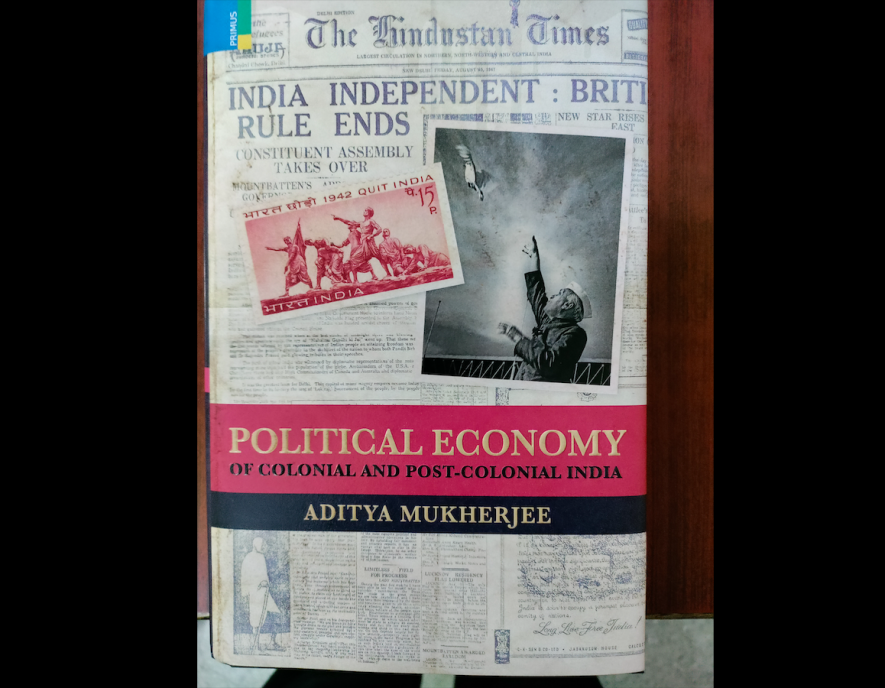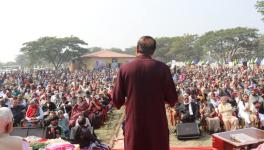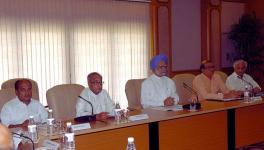Book Review: Political Economy of Colonial and Post-Colonial India by Aditya Mukherjee

Rightly ranked amongst the best historians of modern India, Prof. Aditya Mukherjee’s latest book Political Economy of Colonial and Post-Colonial India, seems to be the answer to a prayer.
2021 was a nauseating year, intellectually, because many books that grabbed the headlines were about people and subjects whose inglorious pasts seemed beyond redemption. Yet a concerted attempt was made to place them on honourable bookshelves by the pliant media. Interestingly, during the entire jamboree, Prof. Mukherjee was seen challenging the conservative opinion lock, stock, and barrel. Never once would it have crossed anybody’s mind that the bespectacled septuagenarian was silently wiping his scabbard to blandish his grand sword, which could cleave even the most hardened lies that fly around as facts. And to accomplish this task, Prof. Mukherjee has chosen the unrelenting pit of political economy.
Prof. Mukherjee, unlike most of the ‘liberal’ critics of the empire, is clear about the fact that the systemic basis of imperialism was capitalism which saw its most complete fruition in Britain. This is not to say that pre-capitalist colonialism was not harsh and perilous. What differentiates the two are the means, scale, and sordid aftereffects. Unfortunately, India suffered a double tragedy, with both forms leading to long-term disasters. Unlike Latin America, where the Iberian pillage stopped with the loot of gold and silver and the colonising state, Spain, for instance, went into costly wars with other European neighbours. India’s pillage by Britain first allowed the Brits to take over the tax regime through which they financed their trade with no accruing returns to the Indians, a process widely known as the ‘tribute’ system, followed by a near-total capturing of India’s domestic market to sell the goods produced in the British factories.
In the first two chapters of the book, Prof. Mukherjee shows these twin processes in their entirety. And in doing so, he carefully chooses the targets of his assault. Chief among them is Tirthankar Roy, the LSE-based economic historian who has supported the colonial argument that because British imperialism allowed India to be integrated with the world market, it experienced economic growth. And this economic growth got a fillip because of the modern modes of transportation and communication developed by the ‘noble’ British imperialists.
In one of his books, Roy has gone to the extent of writing that contact with the British allowed for high literacy rates among the coastal communities like the Parsee merchants. He pegs the female literacy rate among the Parsees at 50% as a great achievement of British occupation. However, he does not acknowledge that in 1951 when 84% of Indians and 92% of Indian women were illiterate, a fact brought to light by Mukherjee (p 63). Mukherjee rightly cites a long quote by Rabindranath Tagore written on the eve of his death in 1941 to show the doom that was spilled over India by the British rule, ‘‘the wheels of fate will someday compel the English to give up their Indian Empire. What kind of India will they leave behind? What stark misery? When the stream of their centuries’ administration runs dry at last, what a waste of mud and filth they will leave behind them’’ (p 63). Or, as John Sullivan, a senior revenue official of the East India Company, put it, ‘‘Our system acts very much like a sponge, drawing up all good things from the bank of the Ganges and squeezing them down on the banks of the Thames."
Another among many of Roy’s ludicrous assertions glorifying British imperialism is that—‘‘had it not been for the rich merchants selling cotton and indigo (to and via the British in different capacities), Indians would not get the Presidency College of Calcutta or the Elphinstone College of Bombay, still two of the best colleges in the country’’ (How British Rule Changed India’s Economy: The Paradox of the Raj p. 15). One wonders at Roy’s temerity and ignorance at the same time. His argument is akin to justifying the trans-Atlantic slave trade, whose benefactors were the premier universities of Britain, Oxford, and Cambridge. In 2019, the University of Cambridge started a two-year academic project to study how much it benefitted from the slave trade. The 2020 demonstrations that brought down the statue of Edward Colston, a rich slave trader from Bristol, was a progressive development. According to estimates, 85% of the wealth used to establish the University of Bristol came from the slave trade. Colston was one of the chief donors.
Would Roy dare to write, in the same vein, about the British education system and the ostensible benefits of the slave trade to it? Of course not! It seems that Universities in the colonising countries still need to come to terms with the horrors wrought by imperialism in the colonised world.
Coming back to the book, Mukherjee clearly shows that one of the many ‘imagined’ benefits of imperialism bandied about by the pro-imperial and pro-market ideologues is that imperialism led to a massive net flow of foreign capital into India. In reality, most foreign capital in the twentieth century came in the form of loans to meet the massive balance of payments deficits caused by unilateral charges made to the metropolis in the form of Home Charges or debt servicing, or interest charges and dividends accruing due to earlier foreign loans or investments.
Mukherjee has also marshalled evidence to argue that ‘‘if one pits the outflow on current account due to interest, dividends and Home Charges against net inflow due to foreign borrowing on the capital account, one will find that there was an outflow of capital from India virtually throughout the colonial period’’ (p. 40).
In fact, after the First World War, most of the sectors controlled and dominated by foreign capital, saw a steady receding of foreign investment. For instance, between 1921 and 1938, the net foreign industrial investment was worth 17 million pounds sterling, whilst the new investment in Indian industry was estimated to be 144 million pounds sterling.
Another major argument of the book is about the rapacious need for markets by a newly industrialising Britain, which is readily found in a colonised India. Whilst the need for a market necessitated a stopping of Indian textile exports and the lookout for an ‘alternative exportable commodity’ that would help in the realisation of the tribute from India. And that commodity was opium. Indian markets were now saturated with British textiles pummelling the local weavers and spinners. The ships that came to offload the textiles went back with opium from India that would be traded in the Chinese market. Innocuous as this arrangement looks, it was one of the nastiest undertakings of British imperialism.
Since the opium that was grown by the Indian peasantry was paid for by Indians themselves (hence the word tribute), it was realised by the sale of opium to China, thereby drugging the Chinese in exchange for tea and silk, commodities for which the British had to pay the Chinese in bullion. Exports of opium from India shot up more than six times between 1816 and 1830. Atul Kohli, in his latest book Imperialism and the Developing World, argues that by 1836, a whopping 35,000 chests of opium were being imported into China, and some 15% of China’s large population became opium addicts. John K. Fairbank has indicted the opium trade as ‘‘the most long, continued and systematic international crime of the modern times’.’
Apart from bodily harm, the Chinese economy suffered massive deflationary pressures because most of it was being paid through silver. In India, the local peasants were coerced under imperial monopoly into growing opium for a very low price, and the silver tael proceeds of the East India Company’s opium exports were used to offset Britain’s deficits with China. In 1855, opium exports to China were worth 6.23 million pounds sterling, paid for most of the tea and silk worth about 8.23 million pounds sterling that Britain took from China (p. 83). Mukherjee has called this process the ‘triangular trade’.
In another major chapter on colonial agriculture, Mukherjee shows that the possibility of the big landlords organising an improving tenantry and a huge labour pool for capitalist agriculture was rare. The chapter becomes important in the context of the debate about the indigenous development of capitalism in India. Through a case study of Assam, it has been shown that what lacked the most was capital with the petty producers who mostly depended on various types of bonded and obligatory labour from those holding larger tracts of land. As a result of which, the surplus appropriated was so much that it involved a substantial portion of the direct producers’ labour required even for his subsistence. Furthermore, the poorer peasantry was subject to rack renting, usury, and high land rent (up to 50%).
Despite high rents, Mukherjee cites two reasons which bookended the possibility for widespread land improvement and the rise of capitalist agriculture. Firstly, the money rent that was paid, albeit exorbitant, was not the capitalist ground rent typical of capitalist agriculture but an absolute ground rent that rested on the monopoly over the best agricultural lands by the big landlords; Secondly, much of the government-owned wastelands were far off and beyond the reach of the poor farmers who had neither the capital nor implements to improve the land.
The book has other very fine entries on the Indian capitalist’s class association with the national movement, Nehruvian planning, which, according to Mukherjee, represented the ‘Left nationalist stand whose main concern was achieving independent anti-imperialist development’ (p. 259). Another fascinating chapter titled Colonialism and Communalism: A Legacy Haunting India Today is a must-read for anyone and everyone who wants to wean India away from the dangerous path of communal hatred.
Right at the outset, Mukherjee warns his readers that ‘‘today communalism is wantonly masquerading as nationalism’’. The distinction between the two, thanks to the (in)glorious WhatsApp University, unrelenting hate campaign by the mainstream media, and untruths about the role of rabid communalists such as Savarkar & Co in the national movement, has been dimmed. This is a dangerous trend.
Arguing against this trend, Mukherjee posits that ‘‘communalism as an ideology is a particular way of looking at and mobilising society which began to be promoted in India in the second half of the nineteenth century, and it is based on the myth that Indian society is divided into homogenous religious communities which shared common economic, political, cultural and social interests’’ (p. 374). The communal assertion is belied by the fact there exists no commonality, barring religious affiliation, between a Muslim or a Hindu landlord and their less fortunate compatriots whose blood and sweat have sustained the formers’ socio-economic exuberance.
Although there exists no basis for communalism, if analysed on the secular lines of class and imperial exploitation, its fury engulfed India leading to bloody vivisection and the rise of religious radicalism in almost all the states that emerged out of it. Mukherjee argues that this was made possible by a conscious attempt by the colonial state. It first began with the publication of James Mill’s History of British India (1826), wherein the history of India was categorised as the Hindu, Muslim, and British periods. This made possible a post hoc communal identification of Indian history. It is no surprise that later communalists took this fallacious categorisation at face value and demonised the Muslims for their rule. The fact that the Muslim cultivator was taxed as exorbitantly as his Hindu counterpart during the so-called Muslim rule continuously evaded the minds of these pernicious communalists.
Indian history is replete with examples of syncretism, both at the elite and the popular level. Historical facts such as Guru Arjan’s invitation to a Muslim saint Mian Mir to lay the foundation stone of Harmandir Sahab (now the Golden Temple) are deliberately omitted to foment animosity among the common people. At the popular level, religious distinctions were so hard to recognise that the Census of India (1911) talked of tens of thousands of people in the Bombay province alone as ‘Hindu-Muhammadans…whose creed and customs partook of both religions’ (p. 376).
Prof. Mukherjee has done a great service by giving us his life’s work in a fine compendium. What makes the book even more important is the timing of its publication. Indians would fare far better and have more arrows in their argumentative quiver against the rising tide of communal fascism if they picked up this book as soon as it hit the stores.
The only difficulty with the book is that it is exorbitantly priced. Indians do not deserve to read a fine history book, that too in these trying times, for Rs 1,950, whilst Savarkar’s two-volume biography (cumulatively running into 1336 pages) is priced at Rs 1,401. I would request the publisher to at least reduce the price of the book by half and make the volume easily accessible to readers.
The writer is a Doctoral Candidate at the Department of Political Science, University of Connecticut, USA.
Get the latest reports & analysis with people's perspective on Protests, movements & deep analytical videos, discussions of the current affairs in your Telegram app. Subscribe to NewsClick's Telegram channel & get Real-Time updates on stories, as they get published on our website.
























